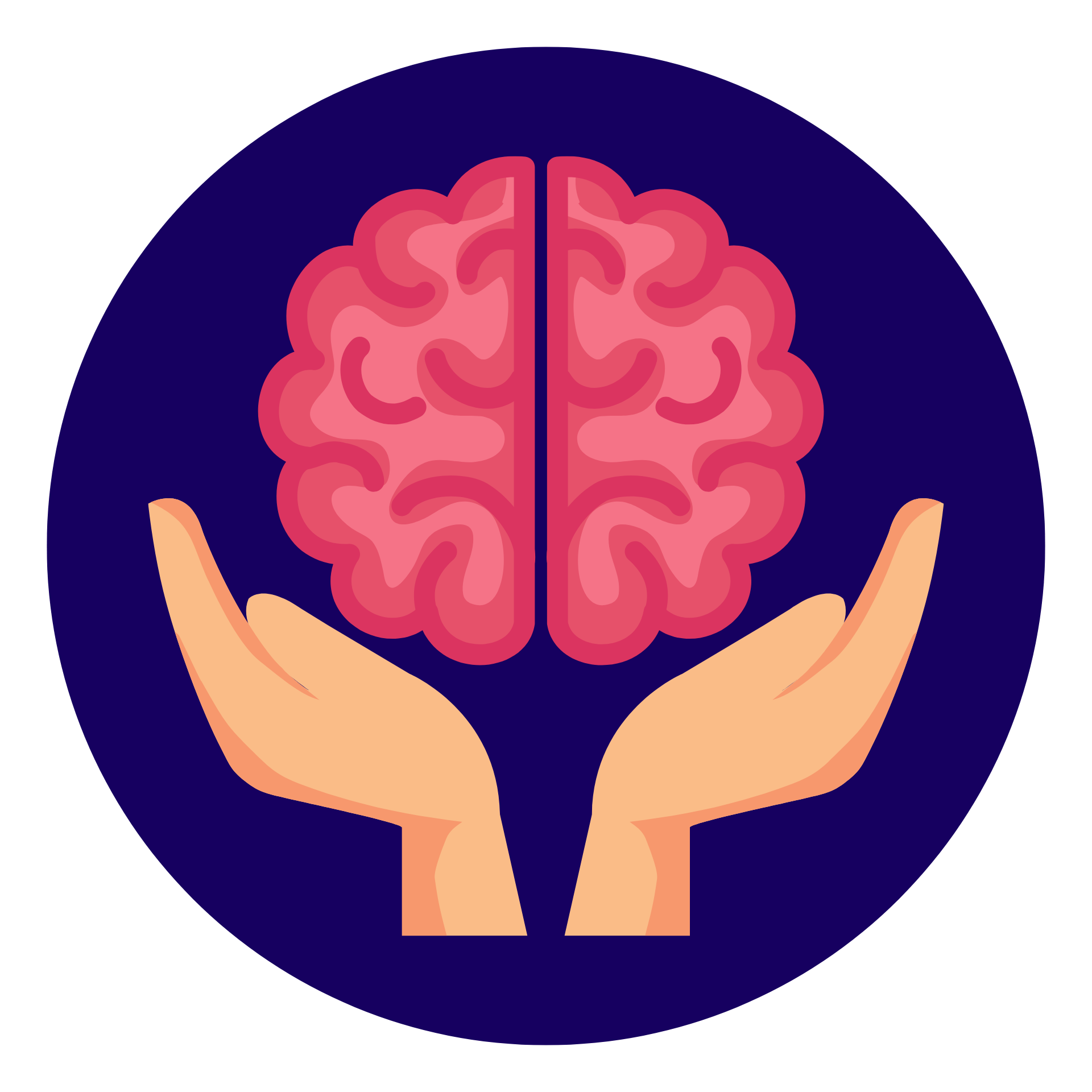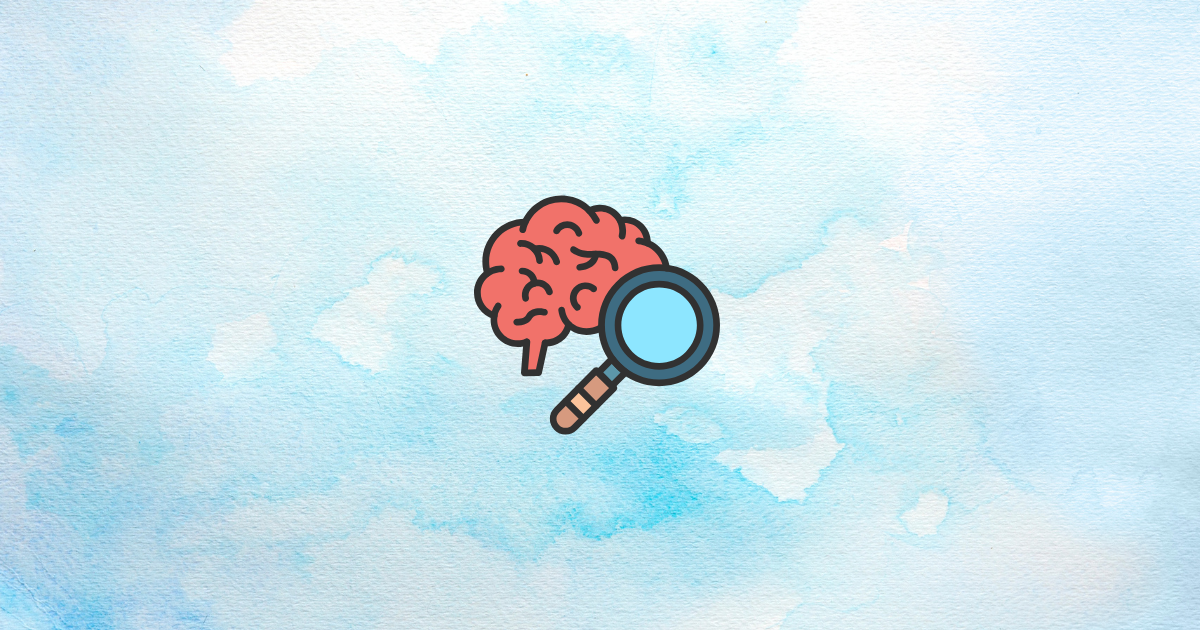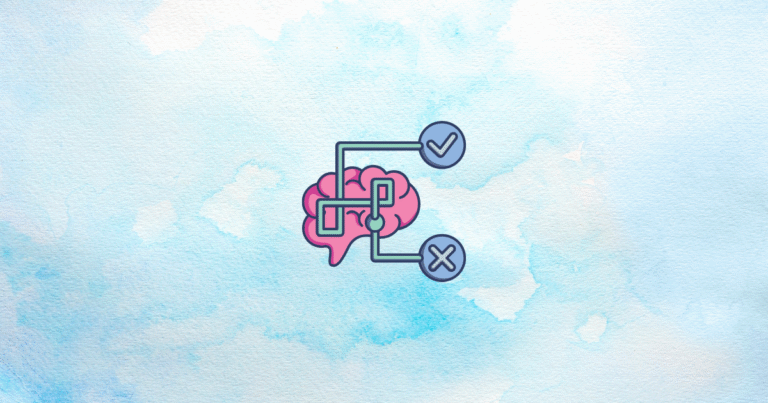Sending a single email is like whispering a suggestion in a crowded room. Sometimes it works, but often it gets lost in the noise. Now, imagine having a thoughtful conversation, building rapport, offering value, and gently guiding your customer towards a decision over several steps. That’s the essence of sequential persuasion, and for Shopify merchants, it’s not just a tactic – it’s a game-changer.
Forget one-off blasts. We’re talking about crafting layered email experiences, sequences that strategically combine psychological triggers to nudge subscribers along their journey. The results? According to Shopify’s own data (looking ahead to 2025 trends), multi-email sequences boast conversion rates a staggering 58% higher than single sends. This isn’t just marketing fluff; it’s rooted in how our brains work, anticipating rewards and building trust over time.
And here’s the good news: Shopify is uniquely built for this. With powerful native automation and seamless integrations, you can create sophisticated, multi-touchpoint sequences that adapt in real-time to customer behavior. Ready to transform your email flows from simple messages into persuasive powerhouses? Let’s dive in.
I. Introduction to Sequential Persuasion in E-commerce
At its core, sequential persuasion is the art and science of structuring your communication over time to gradually influence a decision. Instead of hitting your audience with everything at once, you break down your message, delivering the right points at the right moments.
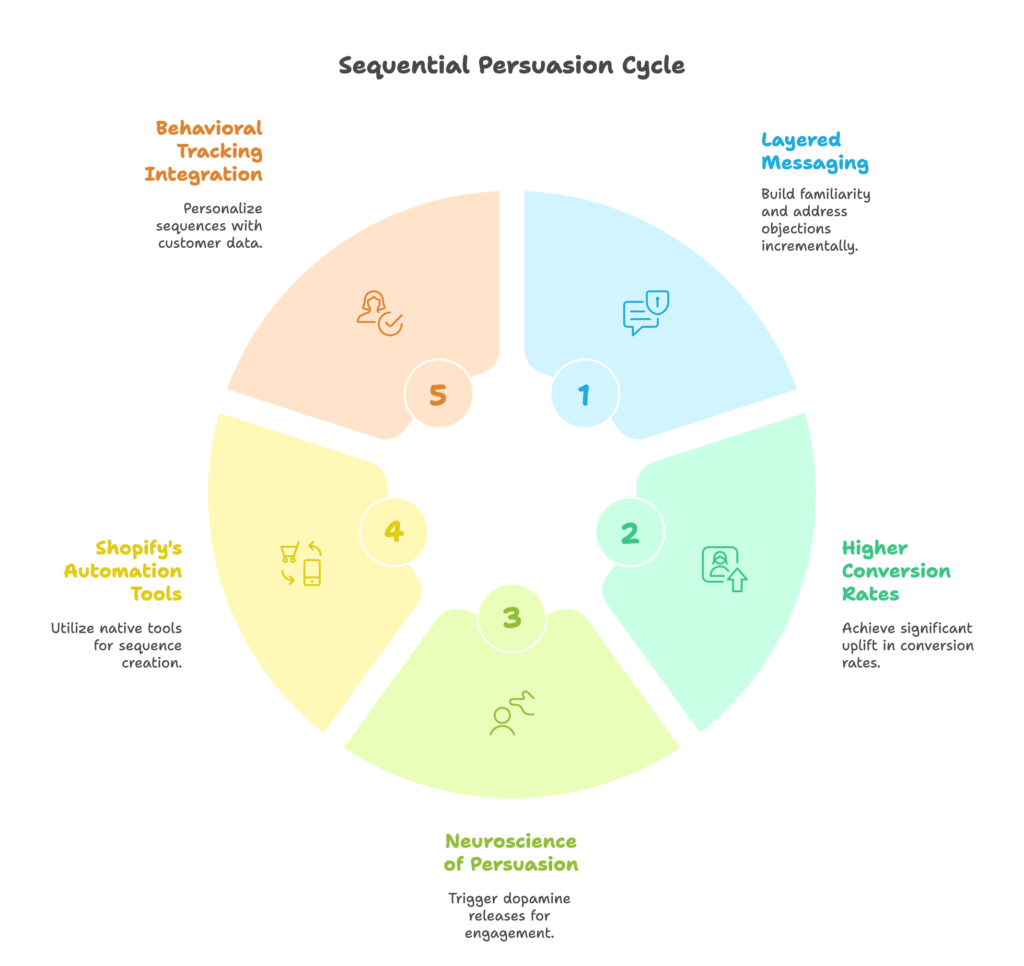
A. The Power of Layered Messaging
Think about building a relationship. You don’t propose on the first date, right? Similarly, effective email marketing nurtures the connection. Layering messages allows you to build familiarity, address different potential objections, and reinforce your value proposition incrementally.
- Higher Conversion Rates: As mentioned, Shopify’s data highlights a significant uplift (58%) for multi-email sequences compared to single emails. Why? Because sequences meet customers where they are, providing relevant information and prompts as they move through their decision-making process. Abandoned cart reminders, welcome series, post-purchase follow-ups – they all perform better as sequences.
- Neuroscience of Cumulative Persuasion: Each positive interaction, each piece of relevant information, can trigger small releases of dopamine in the brain, associated with reward and anticipation. A well-crafted sequence builds this anticipation. A discount offer, followed by social proof, then a touch of urgency – this “dopamine stacking” keeps subscribers engaged and makes the final call-to-action more compelling.
B. Shopify’s Unique Position for Sequential Campaigns
Shopify isn’t just an e-commerce platform; it’s a sophisticated marketing engine, especially well-suited for sequential strategies.
- Native Automation Tools: Shopify Flow and built-in email automation allow you to create sequences with numerous touchpoints (easily 12+ steps). You can trigger emails based on a vast range of customer actions – placing an order, abandoning a cart, Browse a specific collection, signing up for a newsletter, and much more.
- Behavioral Tracking Integration: The platform seamlessly integrates customer data – purchase history, Browse behavior, email engagement – allowing you to personalize sequences in real-time. Someone lingered on hiking boots? Your sequence can automatically adjust to feature related content or offers. This level of personalization makes your layered messages feel less like marketing and more like helpful guidance.
Now that we understand why sequential persuasion is so effective, especially on Shopify, let’s explore the psychological principles that make these sequences tick.
II. Psychological Foundations of Sequential Persuasion
Effective sequences aren’t random; they leverage proven psychological triggers. Understanding these helps you craft flows that resonate deeply and drive action.
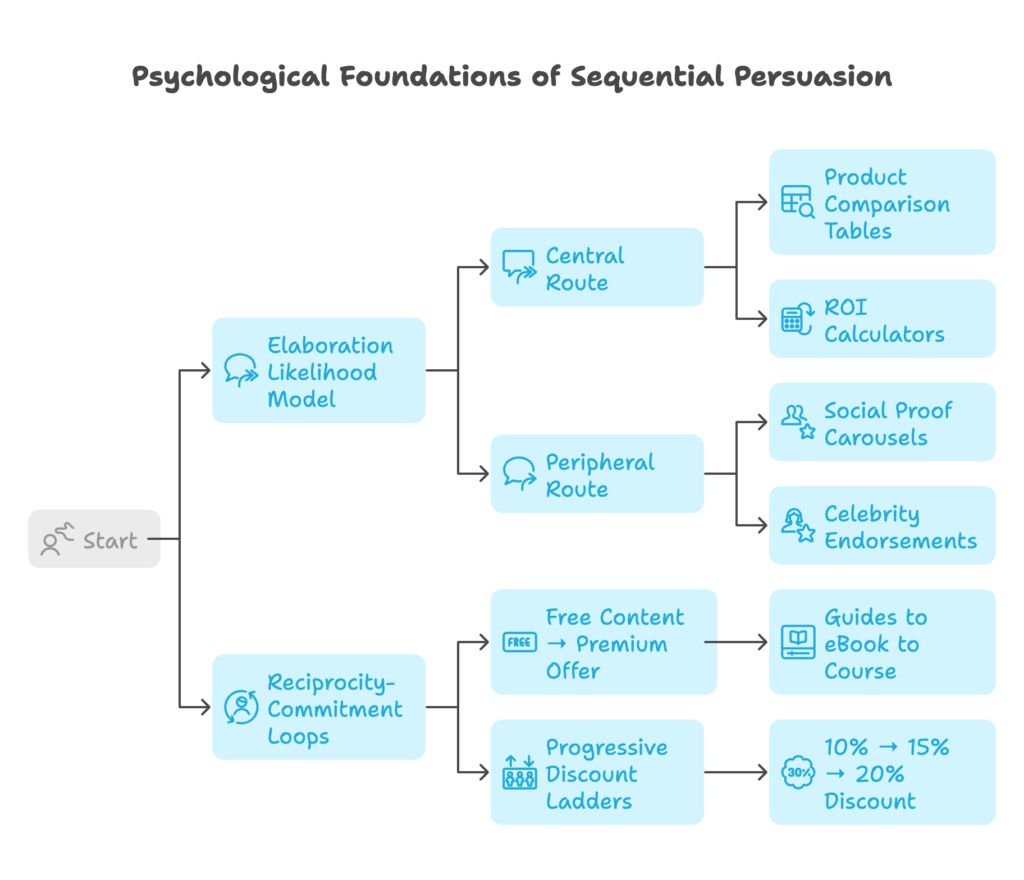
A. Elaboration Likelihood Model (ELM) Implementation
The ELM suggests people are persuaded in two ways: through careful consideration of facts and arguments (central route) or through simpler, often subconscious cues (peripheral route). Great email flows use both.
- Central Route Techniques for Shopify Flows: When your customer is actively engaged and thinking critically (e.g., after a purchase or during B2B consideration), appeal to their logic.
- a. Product Comparison Tables: In a post-purchase sequence for a tech gadget, include an email comparing the purchased model with an upgraded version, highlighting key feature differences and benefits.
- b. ROI Calculators: For a B2B Shopify store selling supplies, a nurture campaign could include an email with a simple calculator showing potential cost savings or efficiency gains from using your products.
- Peripheral Route Enhancements: When attention is lower (like quickly scanning an abandoned cart email), use mental shortcuts.
- a. Social Proof Carousels: Embed customer testimonials or user-generated photos directly within abandoned cart emails. Seeing others happily using the product can be a powerful nudge.
- b. Celebrity or Influencer Endorsements: Feature quotes or images of relevant influencers using your products in your welcome series to quickly build credibility and desire.
B. Reciprocity-Commitment Loops
This powerful combination relies on our innate desire to repay favors (reciprocity) and our tendency to act consistently with previous actions (commitment).
- Free Content → Premium Offer Progression: Give something valuable first to build goodwill, then ask for a small commitment, leading towards the main offer.
- a. “Guides to eBook to Course” Pathways: Offer a free downloadable PDF guide (reciprocity). Later, invite subscribers to purchase a more comprehensive eBook on the topic (small commitment). Finally, promote a full video course for those who engaged with the previous steps (larger commitment).
- Progressive Discount Ladders: Encourage commitment by offering increasing incentives over time, especially effective for cart recovery.
- a. 10% → 15% → 20% Abandonment Recovery: Email 1 offers 10% off the abandoned items. If no action, Email 2 (a day later) offers 15% with social proof. Email 3 (two days later) might offer 20% with a stricter time limit (scarcity). Each step builds on the last, rewarding continued interest.
Understanding these psychological drivers is crucial. But how do you structure them within a practical Shopify flow? Let’s map it out.
III. Designing Shopify Email Flow Architectures
Building effective sequences requires more than just knowing the psychology; it demands thoughtful architecture. You need to map the customer journey and strategically sequence your persuasive techniques.
A. Customer Journey Mapping
Align your email sequences with where the customer is in their relationship with your brand. Different stages require different approaches.
- Awareness Stage Sequences: The goal here is education and engagement, not a hard sell.
- a. 3-Email Educational Drip Campaigns: For new subscribers, send a short series introducing your brand’s mission, highlighting your core product categories, and sharing valuable tips related to your niche (e.g., “3 Ways to Style Your New Scarf”).
- b. Quiz-to-Product Recommendation Flows: Use an interactive quiz (e.g., “Find Your Perfect Skincare Routine”) promoted via email. Based on the results, trigger a sequence recommending specific products tailored to their answers.
- Consideration Stage Tactics: Customers here are actively evaluating options. Your emails should build confidence and address potential barriers.
- a. Social Proof Stacking Across 5+ Emails: In a longer abandoned cart or browse abandonment flow, weave different types of social proof through multiple emails: customer reviews in one, star ratings in another, user-generated content in a third, press mentions in a fourth, “bestseller” badges in a fifth.
- b. Live Inventory Counters in Restock Alerts: When a previously out-of-stock item is available, use a sequence that not only announces the restock but includes dynamic, real-time inventory levels (“Only 7 left!”) in subsequent reminders to add urgency.
B. Persuasion Technique Sequencing
While context matters, certain patterns tend to be highly effective. Think about layering techniques logically.
- Optimal Pattern: Reciprocity → Social Proof → Scarcity: This is a classic, powerful sequence.
- Start by offering value (e.g., a free guide, a small discount) to trigger Reciprocity.
- Follow up by showing how others benefit from or love your products (customer reviews, testimonials) to leverage Social Proof.
- Finally, introduce urgency or limited availability (e.g., “Offer ends soon,” “Low stock”) to employ Scarcity and encourage immediate action.
- Mobile-Optimized Flow Design: Most emails are opened on mobile. Design accordingly.
- a. 3-Second Scroll Depth CTAs: Place your primary call-to-action button high enough in the email that it’s visible within the first few seconds of opening, often before significant scrolling.
- b. Thumb-Friendly Interactive Elements: Use large buttons and tappable elements like carousels or quiz options that are easy to interact with on a small screen.
With the architecture planned, let’s look at the tools you’ll use to build these sequences on Shopify.
IV. Technical Implementation on Shopify
Designing the perfect sequence is one thing; building it effectively within Shopify is another. Luckily, Shopify offers robust native tools and integrates seamlessly with powerful third-party apps.
A. Native Automation Tools
Don’t underestimate the power of Shopify’s built-in capabilities.
- Shopify Flow Configurations: Shopify Flow (available on Shopify Plus, Advanced, and Shopify plans) is your command center for automation.
- a. Predictive Analytics-Triggered Sequences: Use triggers based on Shopify’s own predictive spending tiers (e.g., target high-value customers predicted to spend more) to initiate tailored upselling or loyalty sequences.
- b. Purchase Value-Based Path Branching: Create flows that send customers down different email paths based on their order value. A high-value purchase might trigger a VIP welcome sequence, while a smaller purchase gets a standard post-purchase flow with cross-sell suggestions.
- Liquid Template Customizations: Leverage Shopify’s Liquid templating language for deep personalization within your emails.
- a. Dynamic Product Insertion: Automatically pull product images, names, and prices directly into emails based on a customer’s recent Browse history or abandoned cart items. This makes emails hyper-relevant.
B. App Ecosystem Integration
While Shopify’s tools are strong, dedicated email marketing apps often provide more advanced features for sequential persuasion.
- Klaviyo for Advanced Behavioral Segmentation: Klaviyo excels at creating highly specific customer segments based on intricate behavioral data (e.g., viewed product X three times but didn’t purchase, purchased product Y more than 60 days ago). This allows for incredibly granular sequence targeting.
- Omnisend for Cross-Channel Sequence Orchestration: If you want your sequences to extend beyond email to SMS and push notifications, Omnisend is a great choice. You can build flows where steps trigger messages across different channels for a unified experience.
- Growave for UGC-Powered Persuasion Elements: Apps like Growave help you collect and showcase user-generated content (UGC), reviews, and wishlists. You can integrate these social proof elements directly into your email sequences (using snippets or integrations) to boost credibility.
Mastering these tools allows you to move beyond basic flows into truly sophisticated, revenue-driving sequential strategies.
V. Advanced Sequential Strategies
Once you’ve nailed the basics, you can explore more advanced techniques to maximize the impact of your email sequences.
A. AI-Powered Personalization
Artificial intelligence is revolutionizing email personalization, making sequences even more effective.
- GPT-4 Generated Email Variants per Segment: Use AI tools (potentially integrated within your ESP or via external platforms) to generate multiple copy variations for each email step. Test these variants within specific customer segments (identified by tools like Klaviyo) to find the most persuasive messaging for different audience types.
- Neural Matching of Persuasion Techniques to Buyer Personas: More advanced AI systems can analyze customer data and predict which psychological triggers (scarcity, social proof, authority) are most likely to resonate with specific buyer personas, allowing you to dynamically adjust sequence tactics for maximum impact.
B. Post-Purchase Maximization Flows
The conversation doesn’t end at checkout. Post-purchase sequences are crucial for building loyalty and increasing customer lifetime value (CLTV).
- Review Request → Upsell → Loyalty Program Sequences:
- Step 1: Request a review a suitable time after delivery.
- Step 2: If a positive review is left, trigger an email upselling a complementary product or accessory.
- Step 3: Later, invite satisfied customers to join your loyalty program for exclusive perks.
- Shipping Status → Cross-sell → Referral Incentive Pathways:
- Step 1: Use shipping confirmation/update emails (often highly opened) to include relevant cross-sell recommendations.
- Step 2: After successful delivery confirmation, send an email encouraging referrals, offering an incentive (e.g., discount for both the referrer and the friend).
While these advanced strategies offer immense potential, it’s vital to implement them responsibly.
VI. Ethical Considerations & Best Practices
Powerful persuasion techniques come with responsibility. Building trust requires ethical practices and adherence to regulations.
A. Frequency Capping Guidelines
Bombarding subscribers is the fastest way to lose them. Respect their inbox.
- 7-10 Day Cooling Periods: Implement rules in your ESP to prevent subscribers from receiving multiple major promotional sequences (e.g., a flash sale flow and a new product launch flow) within a short timeframe, like 7-10 days. Allow breathing room between campaigns.
- Preference Center Integrations: Provide clear options for subscribers to manage their email preferences. Allow them to choose the *types* of emails they receive (promotions, newsletters, updates) and the frequency, rather than just a global unsubscribe. This conscious control builds trust.
B. Compliance Frameworks
Legal compliance is non-negotiable.
- GDPR-Compliant Behavioral Tracking: If targeting EU customers, ensure your methods for tracking behavior (used for personalization and segmentation) are fully GDPR compliant, requiring explicit consent.
- CAN-SPAM Act Disclosure Requirements: Adhere to CAN-SPAM rules (primarily for the US), including providing a clear way to unsubscribe, including your physical address, and using non-deceptive subject lines.
Ethical, compliant practices aren’t just about avoiding penalties; they’re fundamental to building the long-term customer relationships that sequential persuasion aims to foster. Does this actually work in the real world? Let’s look at some results.
VII. Case Studies & Performance Metrics
The theory is sound, but the proof is in the pudding. Implementing strategic sequential persuasion delivers tangible results for Shopify stores.
A. Fashion Retailer Results
A mid-sized fashion boutique revamped its abandoned cart flow, shifting from a single reminder to a three-step sequence incorporating social proof and escalating scarcity.
- 37% Conversion Lift: By optimizing the sequence with scarcity elements (timed discounts, low stock warnings) in the later emails, they saw a 37% increase in recovered carts compared to their previous single-email approach.
- 19% Higher CLTV: Implementing a multi-step post-purchase nurturing sequence focused on styling tips, review requests, and loyalty rewards led to a 19% increase in average customer lifetime value over 12 months.
B. SaaS Platform Implementation (Using Shopify for Subscriptions)
A SaaS company using Shopify to manage subscriptions implemented educational drip campaigns for trial users and re-engagement sequences for lapsed subscribers.
- 28% Trial-to-Paid Conversion via Educational Drips: A 5-email sequence educating trial users on key features and benefits resulted in a 28% higher conversion rate from free trial to paid subscription.
- 42% Reduced Churn with Re-engagement Sequences: A carefully timed sequence targeting users nearing subscription renewal or those who had recently cancelled, offering incentives and highlighting new features, reduced churn by 42%.
These examples illustrate the significant financial impact of moving from basic email blasts to strategic, psychologically-informed sequences. And the evolution isn’t stopping here.
VIII. Future of Sequential Persuasion
The landscape of email marketing is constantly evolving. What’s next for sequential persuasion?
A. AR-Enhanced Email Experiences
Imagine emails where subscribers can virtually “try on” apparel or visualize furniture in their space directly from their inbox.
- 3D Product Previews in Flow Sequences: Future email sequences might incorporate augmented reality elements, allowing for interactive product visualizations within welcome or consideration-stage flows, significantly boosting engagement and conversion.
B. Blockchain-Verified Social Proof
Trust is paramount. Blockchain technology could offer new ways to verify authenticity.
- Immutable Review Integration: Integrating blockchain-verified customer reviews directly into social proof emails could enhance credibility, making testimonials even more persuasive within trust-building sequences.
While these future developments are exciting, the core principles of understanding your customer, mapping their journey, and layering persuasive techniques remain timeless. Mastering sequential persuasion today sets you up for continued success, no matter how the technology evolves.
References
- Cialdini, R.B. (2021). Pre-Suasion: Sequential Influence Strategies. Simon & Schuster.
- Shopify. (2025). Advanced Email Automation Guide. https://www.shopify.com/email-sequences
- Baymard Institute. (2024). Cart Abandonment Sequence Optimization. https://baymard.com/abandonment-sequences
- Li, F. & Norman, P. (2021). Sequential Persuasion in Digital Commerce. Journal of Marketing Research.
- Klaviyo. (2025). Behavioral Segmentation Handbook. https://www.klaviyo.com/segmentation-guide
- Omnisend. (2024). Cross-Channel Sequence Case Studies. https://www.omnisend.com/case-studies
Ready to supercharge your Shopify store’s sales with perfectly optimized discount codes? Growth Suite is a Shopify app that helps you do just that, maximizing revenue while preventing coupon misuse. Install it with a single click and start seeing results!
